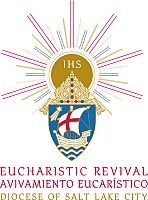Reflection: The Communion Rite Part II
(Editor’s note: This is one in a series of reflections on the importance of the Eucharist and what it means to be a Eucharistic people. These reflections are part of the Diocese of Salt Lake City’s participation in the National Eucharistic Revival, which began last June and will end in July of 2024 with the National Eucharistic Congress in Indianapolis. These reflections are designed to be read aloud at Mass by a priest, deacon or experienced minister following the Prayer after Communion. They will appear in print in this newspaper and on the diocese website, www.dioslc.org. The series of reflections will continue through June in preparation for the July 9 Diocesan Eucharistic Rally at the Mountain America Expo Center in Sandy.)
Whenever we reach an important milestone in life, we try to make sure that we mark that date as something special, and regularly celebrate it as a reminder of what that milestone meant for us. We all know our birthdays, certain anniversaries, and maybe even important dates in our Christian life, such as the date of our baptism or when we received first Holy Communion. The point is that these are monumental moments in our lives.
The Church is a person too – she’s the bride of Christ, and we as the faithful are blessed to call ourselves part of her body. And just like any person, the Church remembers and recalls her important milestones as well – while we remember these moments once a year as they happen, we also remember them every single time we come to Mass.
At this moment in the Mass, after we offer each other the sign of peace, the priest will begin to break the host. This symbolizes and recalls the moment when Christ is pierced in the side on the cross after his death. Many Catholics consider this to be the all-important moment when the Church herself was born, because blood and water (the means by which we are baptized and become members of the Church) spilled forth.
This moment of breaking the bread apart, which we call the fraction rite, allows us as members of the Church to partake in the sacrifice together, to share in the divine meal, and to “break bread” in community. It is a solemn celebration of the Church’s conception, one of those monumental moments in the life of the Catholic faith.
The priest will then break a piece of the host and drop it into the chalice in a moment called the commingling. We should once again remind ourselves that the Mass follows the events of salvation history so that we can relive it and participate in it. The moment of the commingling allows us to relive the moment of the Resurrection. Christ’s body and soul were violently separated at his death on the cross, which we symbolize in the separation of the body and the blood under the appearance of bread and wine. By commingling the two species, the priest symbolically reveals the moment that the body and soul of Christ reunite at the Resurrection. It’s a subtle moment that usually goes unnoticed to the congregation, but it is the commingling that symbolically allows us to participate in the Resurrection.
Now, as a congregation, we join together in chanting the Agnus Dei – “Lamb of God, you take away the sins of the world.” These were the words of John the Baptist when he first laid eyes on Christ. John the Baptist was the one who prepared the way for Christ; he is the personification of salvation history up to the point of Christ’s public ministry and paschal mystery. His words are some of the last we say before we participate in the culmination of salvation history. Up to this point, we have repeatedly been petitioning God to have mercy on us for our sins so that we may soon experience true and everlasting peace. It also reinforces the idea that Christ’s sacrifice was prefigured in the sacrifice of the paschal lamb at Passover in ancient Judaism.
After chanting the Agnus Dei, we return to a kneeling position, reminding ourselves that we are entering an important moment of the Mass that first requires a sense of humility within us. Before, we had knelt when the bread and wine became the body and blood of Christ. Now we kneel in preparation for our reception of the Eucharist.
© Copyright 2025 The Diocese of Salt Lake City. All rights reserved.


Stay Connected With Us